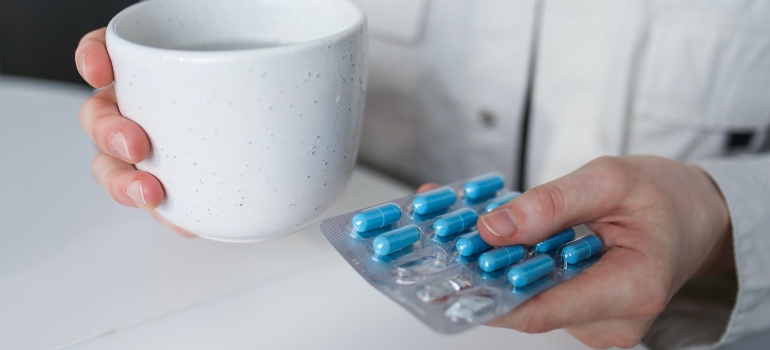Methadone is a medication often used in addiction treatment programs to help individuals struggling with opioid addiction. We want to make this information accessible to everyone, whether you’re someone personally impacted by addiction, a concerned family member, or a community member wanting to understand better. Therefore, as a center for drug and alcohol rehab in West Virginia, we’ll explore the role of methadone in harm reduction strategies, its benefits, and how it can be a stepping stone toward recovery. Our goal is to provide knowledge, hope, and support for those on their journey to a healthier, addiction-free life.
What is harm reduction?
Harm reduction is one of the ways to handle addiction. It’s a philosophy and approach that focuses on minimizing the negative consequences associated with substance use rather than solely demanding abstinence. It recognizes that addiction is a complex and chronic health condition and understands that not everyone is ready or able to stop using substances entirely.

Instead, harm reduction strategies aim to reduce the risks associated with substance use. This can involve various approaches, such as providing clean needles for individuals who inject drugs, offering safe spaces for supervised consumption, or distributing medications like methadone to manage cravings and withdrawal symptoms.
Harm reduction is about meeting individuals where they are on their journey and helping them make safer choices, gradually reducing the harm they may experience while using substances. It’s a compassionate and pragmatic approach that seeks to improve health, reduce overdose risk, and ultimately guide people toward a healthier, more stable life.
The significance of harm reduction in addiction treatment
Harm reduction holds significant importance in addiction treatment for several reasons:
- Reducing Health Risks: Harm reduction strategies aim to minimize the health risks associated with substance use. It can help prevent the spread of infectious diseases like HIV and hepatitis.
- Preventing Overdose: Distributing medications such as naloxone, which can reverse opioid overdoses, is a key aspect of harm reduction.
- Engaging Vulnerable Populations: Many individuals struggling with addiction face multiple challenges, including homelessness, mental health issues, and involvement in criminal activities. These programs can be a bridge to engage these vulnerable populations and connect them to other support services.
- Minimizing Stigmatization: The harm reduction approach reduces the stigma associated with addiction, which may lead those who were reluctant to seek help due to shame to do so.
- Improving Treatment Retention: Harm reduction can be a valuable entry point for individuals into substance abuse treatment. By providing low-threshold services, such as access to medications like methadone or buprenorphine, individuals are more likely to stay engaged with treatment over time.
- Community Safety: Supervised injection sites contribute to community safety by reducing public drug use and improper disposal of used needles.
What is the Mersey harm reduction model?
The Mersey Harm Reduction Model is an approach to addressing drug addiction and related issues, primarily implemented in the Merseyside region of England. Named after the Mersey River, which flows through the area, this model emphasizes inclusive engagement with individuals who use drugs. It places a strong emphasis on providing accessible harm-reduction services.
The Mersey model also encourages individuals to engage with treatment services, which may involve medication assisted treatment like methadone or buprenorphine. It fosters collaboration among community organizations, healthcare providers, and law enforcement agencies to address addiction issues collectively.

This comprehensive approach provides support beyond substance use, recognizing the complex challenges individuals with addiction may face, such as housing instability, mental health issues, and social isolation.
What is the role of methadone in harm reduction strategies?
The role of methadone in harm reduction strategies is significant, particularly for individuals struggling with opioid addiction. Its primary functions within addiction treatment are as follows:
- Opioid Withdrawal Management: Methadone is an opioid medication that is used to alleviate the painful symptoms of opioid withdrawal. This can make the process of withdrawal more manageable and less daunting for individuals.
- Maintenance Treatment: Methadone can be used as a long-term maintenance medication for individuals with opioid use disorder. It provides a stable and controlled source of opioids, reducing the need to obtain drugs from illegal sources.
- Reduction of Cravings: Methadone helps reduce the intense cravings that drive individuals to use opioids.
- Integration into Comprehensive Treatment: Methadone treatment is often integrated with comprehensive addiction treatment programs, including counseling and behavioral therapies. This combination addresses both the physical and psychological aspects of addiction.
- Reducing Mortality: Methadone treatment has been shown to reduce mortality rates among individuals with opioid use disorder.
It’s important to note that methadone treatment should be administered and monitored by healthcare professionals in a specialized clinic or program, such as the opiate rehab West Virginia offers. While it is highly effective in opioid addiction treatment, it also has the potential for misuse and dependence.
How does methadone work to reduce harm?
Methadone is a long-acting synthetic opioid that, when taken as prescribed, binds to the same opioid receptors in the brain as other opioids (e.g., heroin or prescription painkillers). This binding satisfies the brain’s need for opioids, reducing cravings and withdrawal symptoms that happen during fentanyl detox treatment. and other detox programs.
What are the recommendations for methadone?
The safe and effective use of methadone in addiction treatment relies on several important practices. First and foremost, only qualified healthcare professionals in specialized clinics or programs, such as West Virginia heroin rehab, should administer methadone. These professionals should conduct thorough medical assessments to determine the appropriate dosage for each patient.
Throughout the course of treatment, patients must be closely monitored to ensure the medication’s effectiveness and safety. Regular assessments, including urine drug screens, help track progress and identify any misuse. Methadone is generally administered daily under the supervision of healthcare providers, with take-home doses earned over time.
Patients should be well-informed about the potential side effects of methadone and the importance of not mixing it with alcohol or other substances, which can increase the risk of overdose. Additionally, both patients and healthcare providers should be aware of potential drug interactions that may affect the medication’s safety and effectiveness.
When should methadone be started?
Determining when to start methadone treatment is based on the patient’s opioid use history and the severity of their addiction. If someone is already physically dependent on opioids and has failed previous treatment attempts or is at risk of overdose, methadone treatment could be considered.

The process of starting involves an initial dose and adjusting it to prevent withdrawal symptoms and cravings. Patients need to take it under medical supervision at first and be monitored regularly.
During maintenance, challenges can include developing tolerance to methadone, managing side effects, and preventing misuse or diversion. Additionally, pregnant patients and those with co-occurring mental health issues need special care, such as a dual diagnosis treatment.
What is safer than methadone?
The role of methadone in harm reduction strategies is highly effective, but it’s not necessarily safer or more suitable for everyone. Several other medications are available, each with its own advantages and considerations. Here’s a comparison of methadone with buprenorphine and naltrexone.
Methadone: It binds to the same receptors in the brain as opioids like heroin but does so more gradually and with less euphoria.
- Advantages: Effective at reducing cravings and withdrawal symptoms. Long-acting, allowing for once-daily dosing. Proven track record in addiction treatment.
- Considerations: Requires daily dosing, usually under medical supervision initially.
Potential for misuse and overdose if not used as prescribed. Strict regulations and restrictions in some regions.
Buprenorphine: A partial opioid agonist, meaning it activates opioid receptors but to a lesser extent than full agonists like methadone.
- Advantages: Lower risk of overdose due to the ceiling effect. It can be prescribed in an office-based setting, reducing the need for daily clinic visits. Less potential for misuse and diversion compared to methadone.
- Considerations: Limited availability in some areas due to regulatory restrictions. The effectiveness can vary among individuals. It may not be suitable for those with very high opioid tolerance.
Naltrexone: An opioid antagonist, meaning it blocks opioid receptors and prevents the effects of opioids. It is available in oral and long-acting injectable forms.
- Advantages: Non-addictive and does not cause physical dependence. Suitable for individuals who want to avoid opioid-based medications. Long-acting injectable naltrexone eliminates the need for daily dosing.
- Considerations: Requires complete opioid detoxification before starting, which can be challenging. It does not reduce cravings and may not be as effective at preventing relapse as methadone or buprenorphine. Non-compliance can lead to a loss of protection against opioid use.
Can you live a normal life on methadone?
Living a fulfilling and productive life while on methadone maintenance treatment is entirely possible. However, addressing the stigma and misconceptions surrounding it is crucial. Many believe that it merely substitutes one addiction for another, but in reality, it’s a medically supervised treatment.
Some may question the compatibility of methadone with recovery, thinking that recovery necessitates complete abstinence, but recovery is a highly individualized process. For some, the goal is abstinence, while for others, achieving a stable and productive life with methadone is the desired outcome.

Moreover, it significantly reduces the risk of overdose and lowers the risk of infections, highlighting its importance in harm reduction. Effective methadone programs integrate counseling, therapy, and support services, providing a comprehensive approach to recovery that addresses the psychological and behavioral aspects of addiction. Research also supports the fact that methadone maintenance reduces criminal activities associated with obtaining and using illicit drugs.
Duration of Methadone Treatment
The duration of stability in methadone treatment can be quite variable, depending on individual circumstances. It begins with an induction phase, during which the patient’s methadone dose is adjusted to alleviate withdrawal symptoms and cravings, usually taking several weeks.
Subsequently, in the stabilization phase, the goal is to find the most effective methadone dose, which can take weeks to months to achieve as healthcare providers carefully monitor and adjust the dosage. The time it takes to reach stability varies widely among individuals.
Moreover, treatment goals play a crucial role, as some may opt for long-term methadone maintenance while others work towards complete tapering. Healthcare providers regularly assess patients to determine their stability by evaluating the absence of withdrawal symptoms, minimal cravings, and improvements in social and psychological functioning.
For those planning to transition off methadone, there is an exit plan. It outlines the steps and timeline for dose reduction and potentially transitioning to other treatment approaches or abstinence.
Tapering off methadone and long-term recovery
Tapering off methadone is a significant step in the journey toward long-term recovery for individuals in methadone maintenance treatment. Here are some key points to consider:
- Individualized Approach: Tapering off methadone should be approached with an individualized plan. There is no one-size-fits-all timeline.
- Gradual Reduction: Tapering typically involves a gradual reduction of the methadone dose over an extended period. This slow reduction helps the body adjust to decreasing opioid levels.
- Regular Monitoring: During the tapering process, healthcare providers will closely monitor your progress.
- Relapse Prevention: The risk of relapse can increase during and after tapering. Strategies to prevent relapse should be an integral part of the plan.
- Lifestyle Changes: Engaging in a healthy and stable lifestyle is essential for long-term recovery. This includes maintaining social support, employment, housing, and overall well-being.
- Flexibility: Recovery is not always a linear process, and it’s essential to remain flexible and open to adjustments.
Methadone Side Effects and Health Implications
Methadone, as with any medication, can result in side effects that individuals might experience. Common side effects include constipation, drowsiness, dry mouth, potential weight gain, excessive sweating, nausea, vomiting, and the possibility of sexual dysfunction. Specifically, opioid medications, including methadone, frequently lead to constipation, which can be managed through a high-fiber diet and adequate hydration.

Methadone itself is not known to weaken the immune system. However, the lifestyle and behaviors associated with opioid addiction, such as needle-sharing and risky sexual practices, can increase the risk of infectious diseases, which can, in turn, affect the immune system.
Effects on the Brain
Methadone primarily affects the central nervous system and, consequently, the brain. It doesn’t have a direct impact on cognitive function or brain health, but it can indirectly benefit the brain by allowing individuals to focus on recovery.
The Important Role of Methadone in Harm Reduction Strategies
The role of methadone in harm reduction strategies and addiction treatment is essential. It offers a path to recovery for individuals who have struggled with opioid addiction. Therefore, It is essential to challenge the stigma and misconceptions surrounding it. It leads individuals to stable, productive, and sober lifestyle. While methadone is not without side effects, these are manageable, and its impact on the immune system is not a direct concern. Together, we can challenge the stigma surrounding addiction, providing individuals with the tools and understanding they need to achieve lasting recovery.



